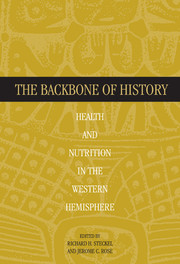Book contents
- Frontmatter
- Contents
- Preface
- List of Contributors
- PART I
- PART II METHODOLOGY
- PART III EURO-AMERICANS AND AFRICAN-AMERICANS IN NORTH AMERICA
- PART IV NATIVE AMERICANS IN CENTRAL AMERICA
- PART V NATIVE AMERICANS AND EURO-AMERICANS IN SOUTH AMERICA
- PART VI NATIVE AMERICANS IN NORTH AMERICA
- Introduction
- 14 A Biohistory of Health and Behavior in the Georgia Bight: The Agricultural Transition and the Impact of European Contact
- 15 Native Americans in Eastern North America: The Southern Great Lakes and Upper Ohio Valley
- 16 Cultural Longevity and Biological Stress in the American Southwest
- 17 Health, Nutrition, and Demographic Change in Native California
- 18 Welfare History on the Great Plains: Mortality and Skeletal Health, 1650 to 1900
- PART VII
- PART VIII
- PART IX EPILOGUE
- Index
15 - Native Americans in Eastern North America: The Southern Great Lakes and Upper Ohio Valley
Published online by Cambridge University Press: 01 March 2010
- Frontmatter
- Contents
- Preface
- List of Contributors
- PART I
- PART II METHODOLOGY
- PART III EURO-AMERICANS AND AFRICAN-AMERICANS IN NORTH AMERICA
- PART IV NATIVE AMERICANS IN CENTRAL AMERICA
- PART V NATIVE AMERICANS AND EURO-AMERICANS IN SOUTH AMERICA
- PART VI NATIVE AMERICANS IN NORTH AMERICA
- Introduction
- 14 A Biohistory of Health and Behavior in the Georgia Bight: The Agricultural Transition and the Impact of European Contact
- 15 Native Americans in Eastern North America: The Southern Great Lakes and Upper Ohio Valley
- 16 Cultural Longevity and Biological Stress in the American Southwest
- 17 Health, Nutrition, and Demographic Change in Native California
- 18 Welfare History on the Great Plains: Mortality and Skeletal Health, 1650 to 1900
- PART VII
- PART VIII
- PART IX EPILOGUE
- Index
Summary
ABSTRACT
A total of 469 individuals are sampled from three Late Archaic (ca. 3000 BP) and four Late Prehistoric (ca. 800–400 BP) Ohio Valley populations and are evaluated for health-related biological indicators.
These samples exhibit generally low frequencies of pathological conditions. Conditions associated with normal wear and tear (degenerative joint disease and, to some extent, trauma) are age associated and are of similar frequencies and severity in the samples. Linear enamel hypoplasia (LEH) is associated with growth depression in the samples, and although the samples exhibit a relatively large average stature, the somewhat smaller stature in Late Prehistoric samples is likely due to their higher frequency of LEH. The greatest difference in pathological conditions among the samples is in the increased incidence of acquired dental pathologies in the maize agricultural Late Prehistoric samples.
In the 2,500-year time span from which these populations were sampled, the overall differences in health indicators, aside from dental health, appear to be small and due to the generally similar biocultural conditions throughout the period.
INTRODUCTION
The culture-historical record of native populations of the middle and upper Ohio Valley is divided into five phases: Paleo–Indian (ca. 12,000–6000 bp), Archaic (ca. 6000–3000 bp), Woodland (ca. 3000–1100 bp), Late Prehistoric (ca. 1100– 400 bp), and Proto-historic (400–200 bp).While a broad outline of the technological, subsistence, and organizational features of populations within these phases has been constructed, at present, biocultural studies are possible only for populations in and following the later part of the Archaic phase.
- Type
- Chapter
- Information
- The Backbone of HistoryHealth and Nutrition in the Western Hemisphere, pp. 440 - 480Publisher: Cambridge University PressPrint publication year: 2002
- 20
- Cited by



